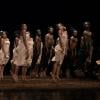
Joaquín De Luz has been called the “Tom Cruise of ballet” for his physical resemblance to the actor and “action-man attack and intensity.” After a stellar two-decade career in New York, including a 13-year stint as a principal dancer with New York City Ballet, he was appointed artistic director of Spain’s Compañía Nacional de Danza (CND) in 2019. Now established with the Madrid-based company, De Luz is bringing his troupe to the Luckman Fine Arts Complex at Cal State LA on Feb. 15 as part of a six-city North American tour.
For its Luckman debut, the company will be performing a trio of works: Sad Case, a 1998 foray into mambo by choreographers Sol León and Paul Lightfoot; Nacho Duato’s White Darkness, which Duato, who directed CND for 20 years beginning in 1990, wrote as a requiem for his sister; and De Luz’s Passengers Within.

Reached by Zoom in Seattle, where CND was dancing the same triple-bill program, De Luz said that after leaving New York City Ballet, he had no definitive plans.
“It was a little bit of uncertainty, and I was ready for that. I spent 23 years plus at Lincoln Center, [which was] more or less a script of what my life was. I embraced uncertainty, and then this opportunity came about.
“It was a really big challenge to go back to my homeland,” said De Luz, who was born in Madrid in 1976. “When you’re away from a country so long, you idolize it, and I had barely worked in Spain before leaving at a young age. I had a completely different picture when I got back. It’s been a tremendous challenge because the system is different from the one I’m used to in America.”
In addition to bringing CND back after the pandemic, De Luz has had other challenges to deal with. He explained that the troupe, because it currently has no home theater, is basically a touring company, and with no private funding, “there is little possibility of growth. It’s very challenging, and the Ministry [of Culture] needs to change. Spain is a beautiful country to sit outside and have a drink and [experience] the good life with good weather, but to get things going is a hassle.”
Nevertheless, De Luz is attentive to his dancers’ needs. “Being on the other side of the room, you try to give back all your career has given you. I’m a father now, so I think, ‘What am I going to give my son?’ At the end of the day, you learn as you go, and the most fascinating [thing] is the work in the studio.”
That studio work includes De Luz creating his own choreography, like for Passengers Within. Premiered in 2022 and set to music by Philip Glass, the work, which features 18 dancers, reflects on today’s technologically dependent consumer society.
“Of course, dancers are always creating in our heads, but choreography was never an urge for me,” De Luz said. “I don’t know when the inspiration came, but I had the opportunity here, directing the company. We came back after COVID, and I thought it would be a brilliant idea to make something in house. That’s how it started; it was a spark.”

With 52 dancers on CND’s roster, De Luz knows what he wants in a company member. “My teacher used to say that a dancer has to be good enough technically so you can get to know them by the way they dance. Those kinds of dancers establish a bridge with an audience.
“I also look for musicality, a well-rounded dancer,” De Luz continued. “I have a big group of dancers that can do a lot of the repertory, from the most academic to the most contemporary, and they [all] have musicality, presence, and technique.”
Asked if ballet has the freedom to be more experimental in Europe than in the States, De Luz replied: “In America more than anywhere, it’s going in the direction of people want[ing] to be entertained. In Europe, people want to be moved. Contemporary companies in Europe and Spain, they always have to talk about these dark subjects, heavy sentiment.
“I want to be happy when I come out of the theater,” exclaimed De Luz. “It’s OK now and then to be dark, but everybody’s so sad. I was just judging a competition in Verona as part of Youth America Grand Prix [the world’s largest student ballet scholarship audition], and all these kids, 12 and 13, they’re doing a contemporary solo, and they’re so miserable, so sad. They haven’t gone through anything in life yet, so how can they connect emotionally? What’s wrong with presenting a happy solo?
“In the United States,” De Luz said, “it’s completely the opposite. You want to have fireworks. These things are almost shallow, [and] you forget about it in three or four days. Maybe meeting in the middle would be a good system.”

The director has some advice for aspiring dancers and choreographers. “Fall in love with the climb, not the top of the mountain. The climbing analogy is important [because] you fall, you get scratched by trees, there’s a lot of physical pain. We fall in love by being at the top, but to cherish the top, you have to love this profession.
“Putting in many hours while friends go out for parties is not work. It’s identity. You have to be in love with the process,” De Luz maintained. “I have to speak my truth. I’ve never stopped climbing. I love what I do and what I am. I thought I was going to slow down when my son came, but I danced La Sylphide at 47 a few months ago. I train a lot. It was not easy, but it was worth it.”




